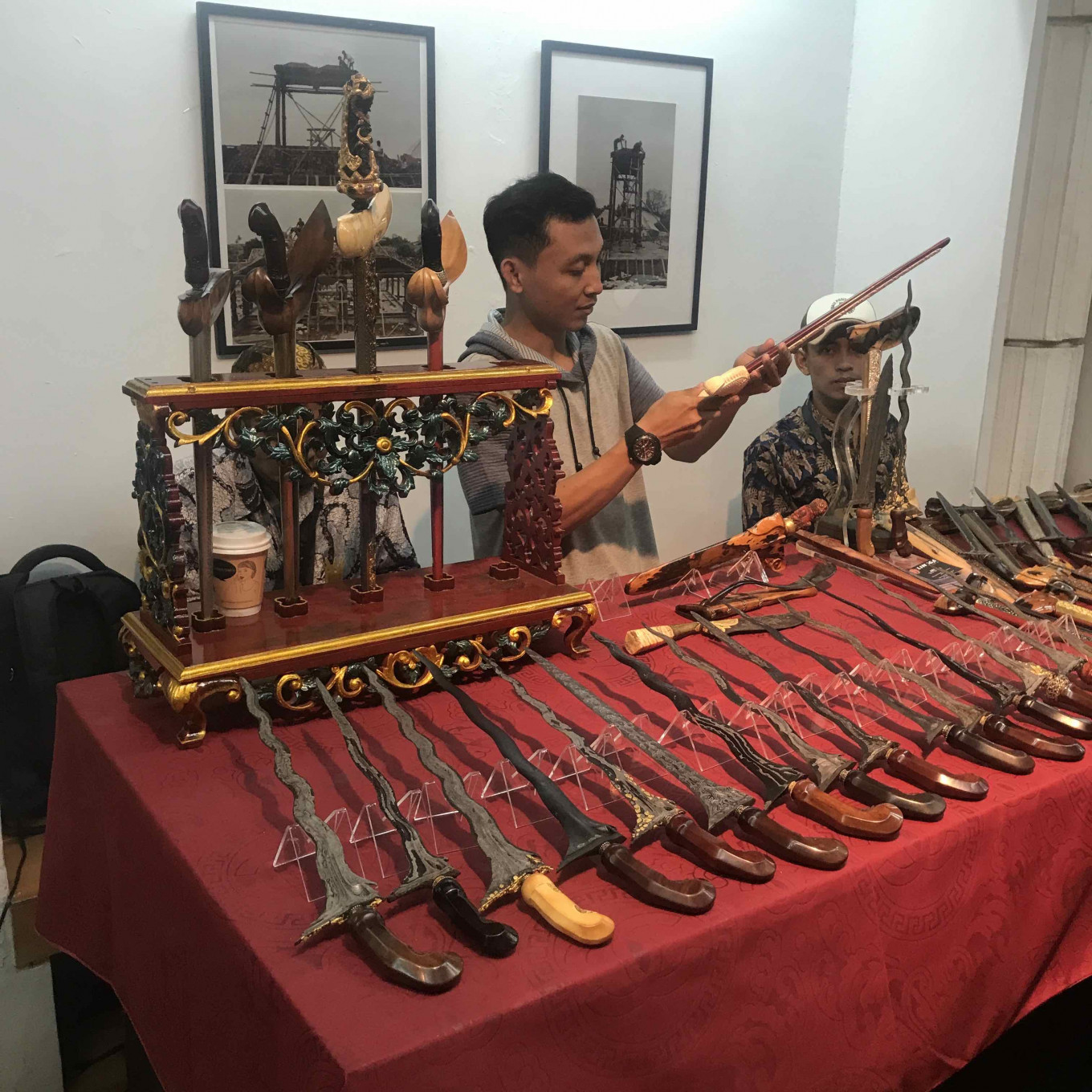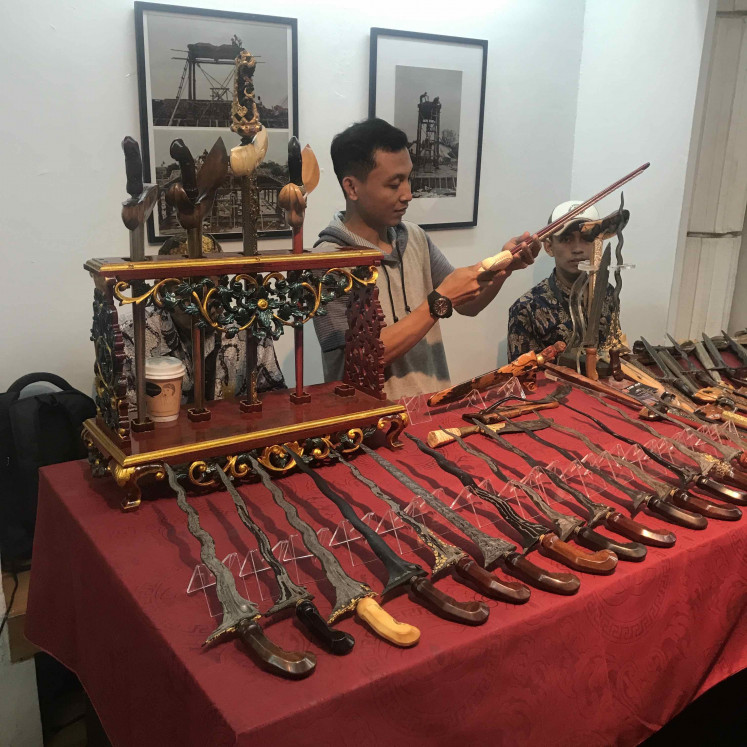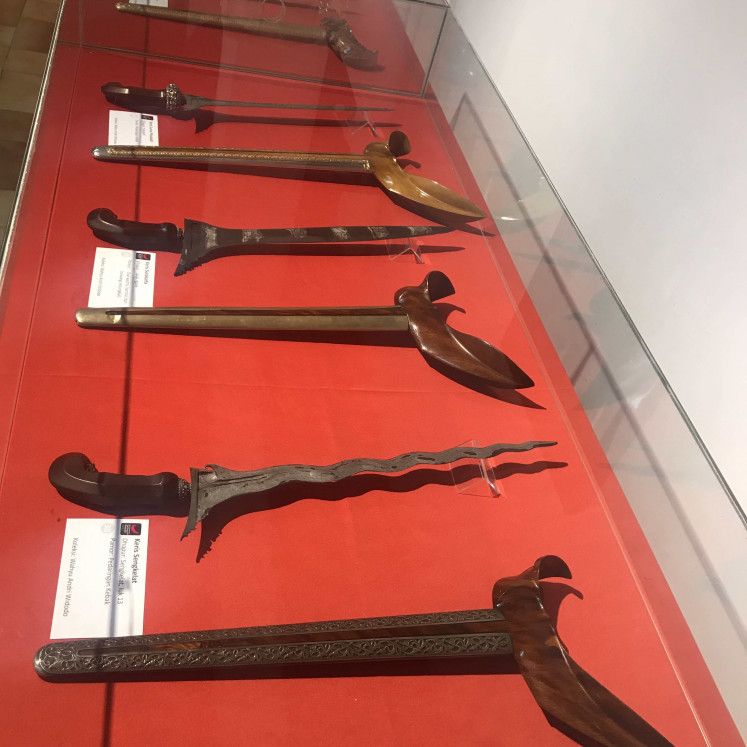Popular Reads
Top Results
Can't find what you're looking for?
View all search resultsPopular Reads
Top Results
Can't find what you're looking for?
View all search resultsAncient ritual shows the kris’ lasting place in the nation’s psyche
To keep the iconic Indonesian dagger relevant today, kris experts carried out the age-old puja rahayu ningrat ceremony at Jakarta’s Bentara Budaya cultural center.
Change text size
Gift Premium Articles
to Anyone
T
o keep the iconic Indonesian dagger relevant today, kris experts carried out the age-old puja rahayu ningrat ceremony at Jakarta’s Bentara Budaya cultural center.
Prince Abiyoso Hadiningrat held the hilt of his kris firmly as he fed its black blade into the kiln. He then pressed the edge of the heated blade to his tongue before cooling the dagger in a basin of air kembang, or water infused with the petals of various flowers. Then, he repeated the steps.
To the untrained eye, Abiyoso’s actions may have seemed like a traditional Indonesian stunt, just as performers in a trance appear to eat glass or stab themselves with their krises in the kuda lumping or barong dances in Java and Bali, respectively. But the venerated elder maintained that there was a method to the apparent madness.
“I had to ensure that the kris struck the right balance between hot and cold,” said the scion of the Pakubuwono dynasty of Surakarta, Central Java. “After all, it does symbolize striking a balance in nature.”
Age-old blade: Krises are displayed at Bentara Budaya. (JP/Tunggul Wirajuda) (JP/Tunggul Wirajuda)A timeless ritual
Abiyoso’s moves were part of puja rahayu ningrat (noble, merciful veneration), an age-old Javanese ritual closely intertwined with the kris. The tradition is the centerpiece of the 2022 Keris Indonesia for Peace and Humanity exhibition at Bentara Budaya, which was held from Nov. 23 to 27 to mark the 17th anniversary of UNESCO’s designation of the dagger as a form of Intangible and Oral Cultural Heritage.
Abiyoso started the puja rahayu ningrat ritual by sitting on a corner of a long table covered with foods like chicken, duck, rice and traditional sweets. Incense wafted around him—much as it did during the ceremony’s inception in the time of the Majapahit kingdom, from the 14th to 16th centuries—as he performed the jamasan (fire and water purification). The ritual is not for the faint of heart, as it entails putting the kris in hot coals, licking it, then dipping the blade in air kembang.
“Aside from balance and purification, licking the kris also determines how clean one's flesh and spirit are,” said Abiyoso, who claimed to have performed puja rahayu ningrat for five Indonesian presidents, including President Joko “Jokowi” Widodo and late strongman Soeharto.
He explained that puja rahayu ningrat purified every part of the kris, not least the luk (curves of the blade), which are always an odd number.
“The average luk number is five to symbolize the five pandawa [heroes] in the Mahabharata epic poem and their virtues such as wisdom, honesty and mercy. The number five also reflects Pancasila, the Indonesian state ideology.”
Gerak Nusantara cultural organization head Revitriyoso Husodo, who organized the event with Bentara Budaya and the Taman Mini Indonesia Indah cultural theme park, agreed with Abiyoso. He said the puja rahayu ningrat ceremony reflected the kris’ place in the Indonesian psyche.
“The philosophy and the virtues symbolized by the kris makes it a symbol of peace. Admittedly, this is a paradox, as the kris is a weapon of war and not the most powerful one, as it can be overpowered by swords or spears and outranged by the latter,” he said.
“But the kris is a powerful symbol that embodies one’s hopes and dreams and instills them in the blade. In short, the kris is a ‘spiritual placebo’ that makes one’s faith and beliefs more tangible.”
Maintaining tradition: A kris vendor shows his collection during the 2022 Keris Indonesia for Peace and Humanity exhibition at Bentara Budaya, held from Nov. 23 to 27. (JP/Tunggul Wirajuda) (JP/Tunggul Wirajuda)Strength in trying times
Puja rahayu ningrat might conjure images of influential political and economic figures who hope to use the ritual to attain their ends. However, organizers sought to dispel this notion. They encouraged those with krises to bring them to be purified. They also allowed viewers to wash their faces with the air kembang or drink it to purify themselves.
“Aside from blessing the kris, [puja rahayu ningrat] serves as a prayer for peace and humanity. In this case, it is relevant in a world reeling from COVID-19, an economic recession and conflicts like the war between Russia and Ukraine,” Revitriyoso said.
“The ritual and kris filled the spiritual void superficially filled by gadgets or substances. Yet enlightening the public is still an uphill climb, especially as the kris is still seen as a relic of an agrarian age and is associated with superstition and mysticism. Perhaps the biggest challenge comes from hardline interpretations of Islam and other religions in recent years which view the kris as idolatry.”
While Revitriyoso is concerned that the kris is on the back foot against modernization, kris vendors like Tio of Wesi Aji Keris remain upbeat.
“Opening the kris stand [at Bentara Budaya for the kris exhibition] did wonders for business, as I can take five to seven orders, compared to one to three customers at our kiosk in the Jatinegara jewelry market,” he said.
“Our most popular wares are kris designed as lucky charms. Demand for them is universal among young and old alike.”
His fellow kris seller Joko Supriyadi of JS Collection, agreed. “Technology might be a challenge to public demand for kris, but in my case, it proved helpful,” he asserted.
“Most of my customers, especially young people, were drawn by my YouTube channel Jscollectionkrisadi rather than my shop.”
Nahdlatul Ulama (NU) Islamic organization cultural expert Zastrouw al-Ngatawi summarized the kris and its associated puja rahayu ningrat ritual best.
“The kris’ shapes and contours are like a book and spiritual road map of Indonesia’s development through the ages. One needs to ‘read’ them like a book, an element lost because of a narrow, literal understanding of an Islamic caliphate and sharia,” he said.
“The kris’ flowing form also teaches one to be more sensitive to nature, an indispensable element as many current problems stem from rampant modernization. But though the kris as a cultural tradition can serve as a guide to the future, one should not venerate them, nor romanticize them as a product of a halcyon past.”













